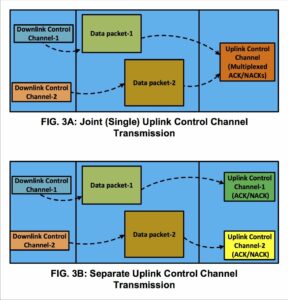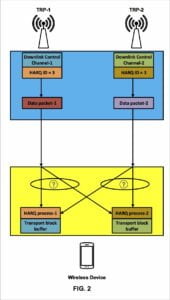Herndon, VA – Fifth generation (5G) wireless networks are expected to support massive connectivity, high capacity, ultra-reliability and low latency. Such diverse use case scenarios require disrupting approaches for the realization of future 5G systems. It is envisioned that multiple transmission and reception points (multi-TRPs) will be vital in 5G in order to improve reliability, coverage, and capacity performance through flexible deployment scenarios. For example, to be able to support the exponential growth in mobile data traffic in 5G and to enhance the coverage, the wireless devices are expected to access networks composed of multi-TRPs (i.e., macro-cells, small cells, pico-cells, femto-cells, remote radio heads, relay nodes, etc).
The users on the cell-edge are usually served with a low quality-of-Service (QoS) due to the comparatively long distance from the base station and unfavorable channel conditions (e.g., intercell interference (ICI) from neighboring base stations). Multi-TRP is a key technology that has been studied in fourth-generation (4G) mobile communication to alleviate the ICI via dynamic coordination between the multi-TRPs, to provide joint scheduling and transmissions/receptions. In this way, a wireless device at the cell edge can be served by multi-TRPs to improve its signal transmission/ reception resulting in increased throughput [1].
Although fourth-generation (4G) networks support multi-TRP schemes, the supported features are limited to accommodate newly identified deployment scenarios in 5G. For example, transmission of multiple control signals via multi-TRPs may be beneficial to improve reliability of the ultra-reliable low latency communication (uRLLC), vehicle-to-everything (V2X), and high-speed train use cases by providing link diversity gain, especially for the cell edge users, which has not been studied in 4G. Moreover, high carrier frequencies (e.g., millimeter waves) in 5G facilitate deployment of a large number of antennas (e.g., so called massive-MIMO) at the base-station, which requires beam management procedures for multi-TRP technology, which are not currently supported by 4G. Finally, 4G multi-TRP operations cannot sufficiently support practical scenarios such as non-ideal backhaul, and therefore cannot provide deployment flexibility (e.g., non-collocated TRPs) resulting in a provision of a small/moderate cell edge performance gain [2]. Therefore, multi-TRP technology in 5G not only handles the ICI as in 4G, but also significantly improves spectral efficiency and reliability as well as boosts data transmission via aggregating resources from multi-TRPs.
Multi-TRP technology in 4G assumes an ideal backhaul, which requires a highly detailed feedback (e.g., channel state information) and close coordination between the TRPs. When multiple TRPs are connected with a non-ideal backhaul, the joint scheduling among the TRPs may not be feasible due to delay of coordination of control signals and/or data packets among different TRPs or limited backhaul capacity, resulting in a poor link adaptation (or performance loss). 5G should support a wide range of physical deployments and be able to maximally leverage from centralization, while also supporting distributed base stations and being able to operate in non‐ideal backhaul [3]. In particular, multi-connectivity, that is, a wireless device receiving multiple independently scheduled data streams from different TRPs simultaneously, is useful under the case that the multiple TRPs are connected with a non-ideal backhaul. With independent scheduling, operators can improve QoS without investing in expensive infrastructure to achieve an ideal backhaul. Moreover, high frequency bands in 5G suffer from link blockage and coverage. Therefore, employing multiple independent links via multi-TRPs provides a robust structure against blockages and beam failures.
4G made further improvement in LTE-Advanced Pro, Release 15 supporting operations of multi-TRP, such as coordinated scheduling, coordinated beamforming and dynamic point selection/dynamic point blanking.
However, these operations fail in satisfying the 5G requirements in practical scenarios with a non-ideal backhaul [4]. To address this issue, an agreement that multiple downlink control channels, each scheduling a respective data packet, where each data packet is transmitted from a separate TRP, as shown in FIG. 1, was achieved in Release 15 [5], and further discussions are halted due to time limitations. This agreement enables non-coherent joint transmission, by relaxing the backhaul and synchronization requirements (e.g., agnostic to the nature of the backhaul link) in the multiple TRPs, since each TRP can independently schedule a transmission without exchanging channel state information, scheduling information, etc with other TRPs.

Below, we discuss the potential challenges for multi-TRP technology shown in FIG.1.
1) Indication of the maximum number of PDCCHs
As a wireless device employs blind detection algorithm for downlink control channel decoding, prior information of the maximum number of downlink control channels transmitted from multi-TRPs to detect is useful to reduce the downlink control channel searching time. When configured with multiple TRPs, each scheduling a data packet, the wireless device can stop the blind detection when the maximum number of downlink control channels have been successfully decoded. Otherwise (e.g., if there is no prior information), the wireless device performs blind detection for all possibilities of downlink control channel candidates across the search space(s). The methods for the indication of the maximum number of downlink control channels to decode may be implemented via radio resource control signaling or via downlink control information which enables a faster indication.
2) Number of data layers
Due to independent scheduling at each TRP, the total number of data layers scheduled to the wireless device can exceed the maximum number of data layers the wireless device can support. One alternative to avoid this scenario is to drop the processing of some of the data layers (or data packets) and transmit an indication of the drop (e.g., with a negative acknowledgement (NACK) reporting). Another alternative is that the number of transmitted layers from each TRP should be limited, for example to floor{L/N}, where L is the maximum number of supported data layers and N is the number of TRPs scheduling individual data packet.
3) Hybrid automatic repeat request (HARQ) Process Design
For reception of multiple downlink control channels from the multi-TRPs, the wireless device should handle transport blocks (e.g., data) in different data packets in separate HARQ processes, otherwise the ambiguity of HARQ process number indicated in the downlink control channels scheduling respective data packets from different TRPs will lead to errors in HARQ related operations.
However, even though separate HARQ process is used, as shown in FIG. 2, if the different downlink control channels scheduling transmitted from different TRPs indicate the same HARQ identity (ID), the wireless device may fail in distinguishing the data packets and identifying the correct HARQ process sets associated with the data packets.
4) ACK/NACK Transmission
For a wireless device receiving multiple downlink data packets simultaneously from multi-TRPs, multiple acknowledgement (ACK)/NACKs associated with the multiple data packets are transmitted to the base station. There are two options for the transmission:
- Joint (Single) uplink control channel transmission: As shown in FIG. 3A, the wireless device multiplexes ACKs/NACKs of downlink packets and transmits it on a single uplink control channel resource.
- Separate uplink control channel transmission: As shown in FIG. 3B, the wireless device transmits ACK/NACKs of received data packets on a separate uplink control channel resource, each to a different TRP scheduling the corresponding data packet.
While separate uplink control channel transmission is a simpler scheme due to independent operation for each TRP, it requires simultaneous multiple uplink control channel transmissions which imposes challenges to a radio frequency (RF) implementation of the wireless device. Another issue is how to allocate a transmission power of each simultaneous uplink transmission A collision resolution mechanism to solve the overlapping uplink transmissions is required.
On the other hand, in the joint (single) transmission, for example, the ACK/NACK of one TRP (e.g., TRP-2) received at another TRP (e.g., TRP-1) would have to be carried from TRP-1 to TRP-2 over the non-ideal backhaul link. This may result in performance loss due to the ACK/NACK delay of the non-ideal backhaul.
 About Ofinno
About Ofinno
Ofinno develops wireless technologies that address some of the most important technological issues in modern life today. Our wireless technology innovators create new technologies that have an astounding 67% utilization rate, producing tangible results for both wireless device users and carriers alike. At Ofinno, the people inventing the technologies are also in charge of the entire process, from the idea, through the design and right up until the technology is sold. Ofinno’s research focuses on fundamental issues such as improving LTE-Advanced performance, Mission Critical Services, Inter-Band Carrier Aggregation, New Radio for 5G, V2X, IoT, and Power Management. Our team of scientists and engineers seek to empower mobile device users and the carriers that serve them through cutting edge network performance innovations.
References
[1] 3GPP, TR 36.819, “Coordinated multi-point operation for LTE physical layer aspects,” 2013.
[2] J. Liu, et al., “Initial access, mobility, and user-centric multi-beam operation in 5G new radio,” IEEE Communications Magazine, vol. 56, no. 3, pp. 35–41, March 2018.
[3] P. Marsch et al., “5G radio access network architecture: design guidelines and key considerations,” IEEE Communications Magazine, vol. 54, no. 11, pp. 24–32, 2016.
[4] R1-1807130, “Discussion on the multi-TRP/panel transmission in NR,” Huawei, HiSilicon, 3GPP TSG RAN WG1 Meeting #93, Busan, Korea, May 21st – 25th, 2018.
[5] R1-1712031, “Final Report of 3GPP TSG RAN WG1 #89 v1.0.0,” Hangzhou, China, May 15th-19th 2017.


